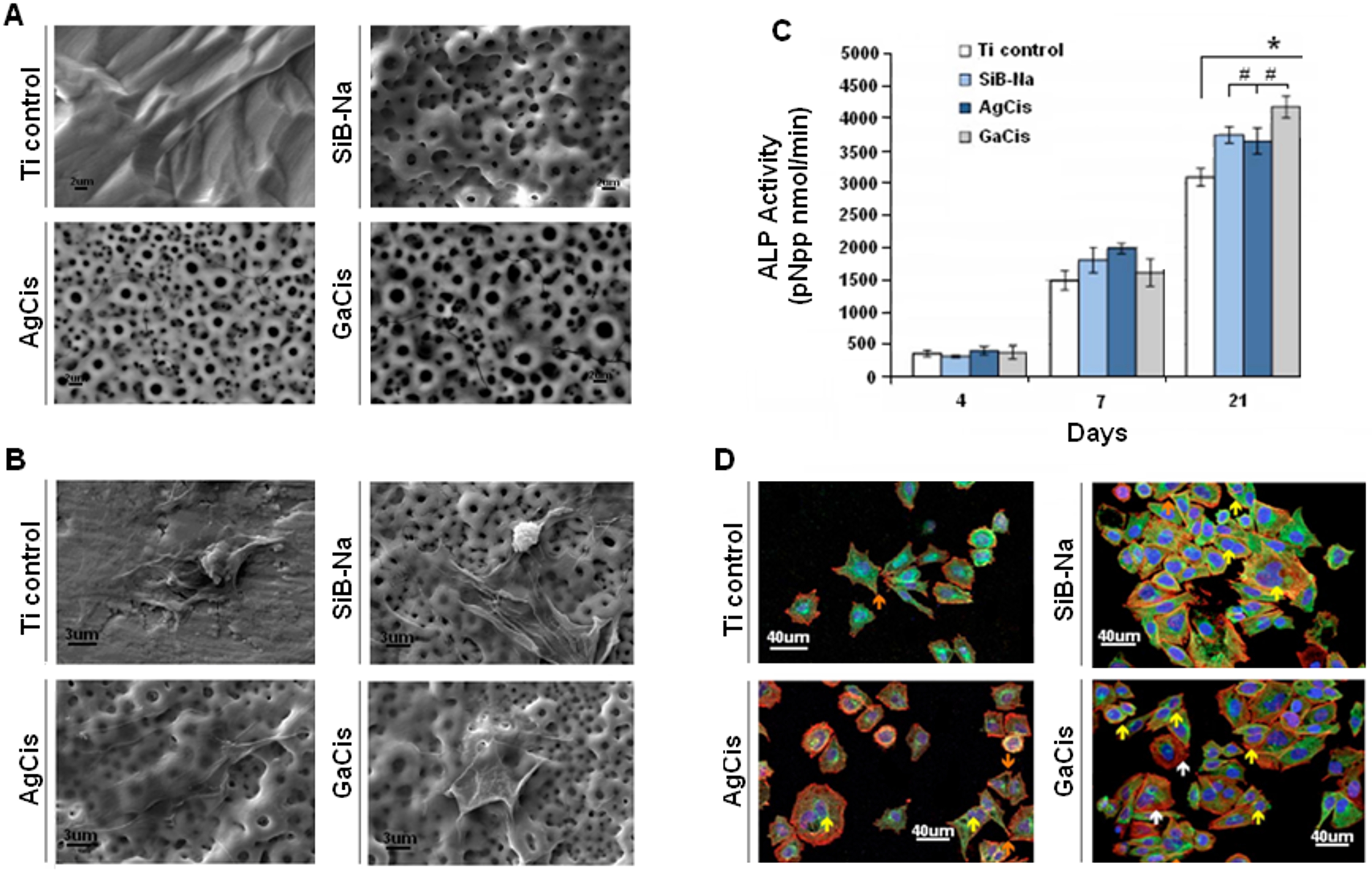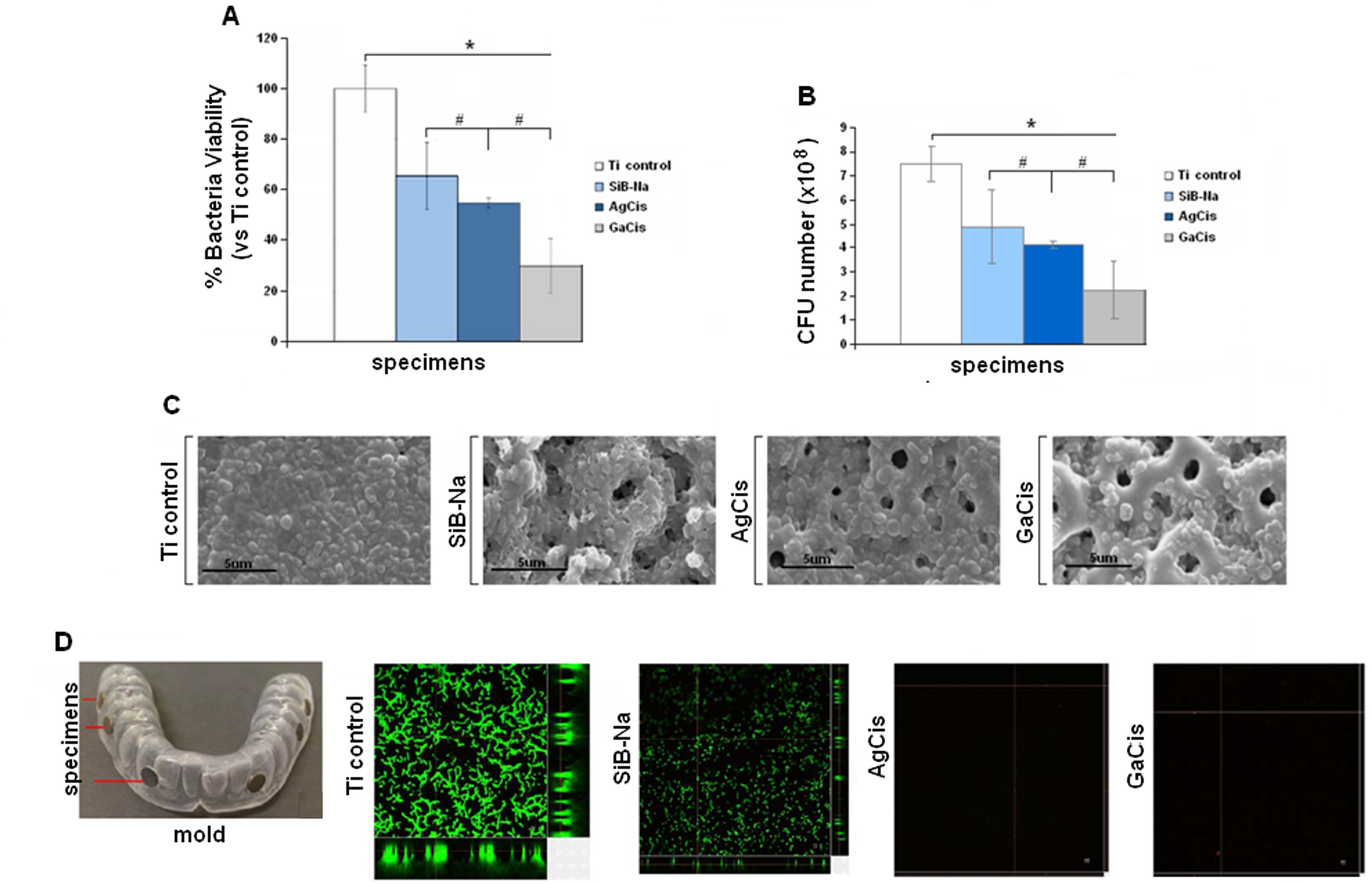Introduction: Infections related to biomaterial implantation are a major clinical problem, bringing high rates of morbidity and mortality [1]. The World Health Organization (WHO) recognized Multi Drug Resistant (MDR) pathogens with the acronym “ESKAPE” [2] as the most dangerous agents in hospital-acquired infections [3]. Gallium has recently described as potential anti-bacterial element. Moreover, its anti-resorptive effects have been revealed since it is able to stop osteoclast resorption. Here we discuss the anti-bacterial and pro-osteointegrative properties of gallium doped biomimetic titanium devices.
Materials and Methods: Titanium was electrochemically modified by the Anodic Spark Deposition (ASD) treatment [4] to gain osteointegrative properties (SiB-Na), and improved to insert gallium (GaCis). Acinetobacter baumannii was chosen as Multi Drug Resistant (MDR) strain to test GaCis killing activity by CFUs count and XTT analysis, while human osteoblasts were used to evaluate its osteointegrative properties by ALP activity and Immunofluorescent (IF) analysis. SEM assayed cellular morphology. Silver doped titanium (AgCis) was the control. Finally, custom-made PVC molds equipped with test specimens were worn for 24 hours by healthy volunteers and investigated in a Live/Dead assay by confocal microscopy (CSLM) .
Results: The ASD technique was useful to develop (i) the biomimetic coating SiB-Na and (ii) the gallium or silver enrichment. Surfaces SEM images are reported in Figure 1A. Human osteoblasts successfully adhered (B). When ALP activity was measured (C), a statistical significant difference was noticed between GaCis and untreated control (p<0.05, indicated by *) or other specimens (p<0.05, indicated by #) after 21 days culture. IF staining confirmed tubulin cellular expression (D, yellow arrows).

As shown in Figure 2, gallium decreased number (A) and viability (B) of A. baumannii biofilm with significant differences between untreated control (p<0.05, indicated by *) and other specimens (p<0.05, indicated by #). SEM observations confirmed these data (C). Finally, CSLM analysis (D, in green) showed a significant reduction in vivo of bacteria adhesion onto gallium doped specimens.

Discussion: Gallium is metabolically very similar to Fe3+ in terms of charge, ionic radius, electronic configuration, and coordination. Thus, it can act as an iron substitute with a “Trojan horse” strategy in several biological pathways. Since Ga3+ cannot be reduced under the same conditions as Fe3+, sequential redox reactions, critical for the biological functions of Fe3+, are impaired when iron is replaced [5][6].
Conclusion: These substrates were found to favor new bone production. Moreover, the antibacterial agents embedded in the ASD-modified titanium oxide, gave bacteriostatic and bactericidal properties to the treated titanium, in particular by strongly inhibiting the formation of biofilm by A. baumannii.
References:
[1] Armentano I, Arciola CR, Fortunati E, Ferrari D, Mattioli S, Amoroso CF, et al. The interaction of bacteria with engineered nanostructure polymeric materials: a review. Scientific World Journal. 2014; 2014:410423. doi 10.1155/2014/410423.
[2] Bassetti M, Ginocchio F, Mikulska M. New treatment options against gram-negative organisms. Crit Care. 2011; 15: 215. doi: 10.1186/cc9997.
[3] Howard A, O'Donoghue M, Feeney A, Sleator RD. Acinetobacter baumannii: an emerging opportunistic pathogen. Virulence. 2012; 3:243-50. doi: 10.4161/viru.19700.
[4] Della Valle C, Rondelli G, Cigada A, Bianchi A.E, Chiesa R. A novel silicon-based electrochemical treatment to improve osteointegration of titanium implants. J Appl Biomater Function Mater. 2013; 11: 106-16. doi: 10.5301/JABFM.2012.9419.
[5] Rimondini L, Della Valle C, Cochis A, Azzimonti B, Chiesa R. The biofilm formation onto implants and prosthetic materials may be contrasted using Gallium (3+). Key Eng Mat. 2014;587:315-320. doi:10.4028/www.scientific.net/KEM.587.315.
[6] Cochis A, Azzimonti B, Della Valle C, Chiesa R, Arciola CR, Rimondini L. Biofilm formation on titanium implants counteracted by grafting gallium and silver ions. J Biomed Mater Res A. 2015; 103: 1176–1187. doi: 10.1002/jbm.a.35270.